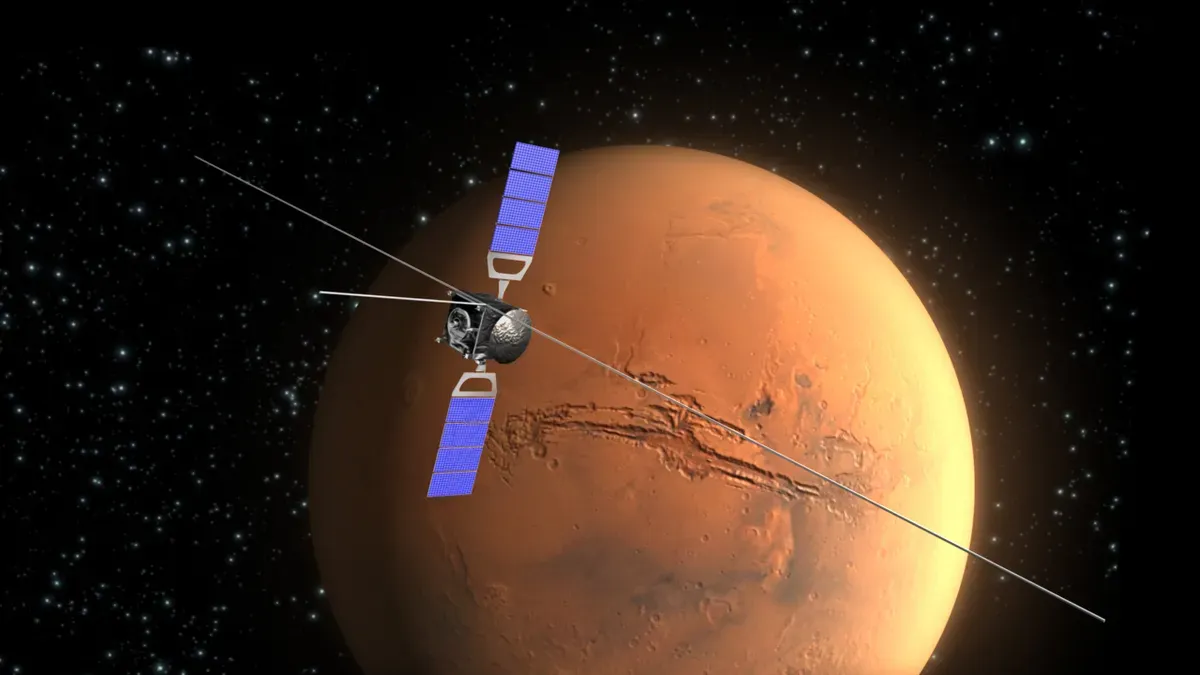
When astronomers spotted 3I/ATLAS on 1 July 2025, they immediately knew it was special. It wasn’t just another comet from the distant reaches of our own Solar System. Its speed, trajectory, and chemistry revealed it as the third confirmed interstellar object ever observed crossing into our cosmic neighborhood.
In just a month, on 3 October 2025, this ancient visitor will sweep past Mars at a distance of around 30 million kilometers. For the first time, an interstellar comet will pass close enough to a planet hosting multiple orbiters capable of detailed observation. European spacecraft circling the Red Planet are now preparing for a once-in-a-lifetime opportunity.
1. What is 3I/ATLAS?
3I/ATLAS is an icy body hurtling into the Solar System on a hyperbolic path — meaning it is not bound to the Sun and will never return once it leaves. It is estimated to be 7 to 14 billion years old, possibly older than our Solar System itself. That makes it a time capsule from the earliest days of galactic history.
Unlike most comets we are familiar with, 3I/ATLAS carries an unusual chemistry. Early observations revealed that its coma — the cloud of gas surrounding its icy nucleus — is especially rich in carbon dioxide, alongside water vapor, carbon monoxide, and traces of exotic molecules. This suggests it may have formed in an environment very different from our own solar nursery.
2. Why Mars, and Why Now?
The comet’s closest pass will not be near Earth but near Mars. This is extraordinary because Mars currently hosts a fleet of orbiters equipped with powerful cameras and spectrometers. These spacecraft can provide a much closer look at 3I/ATLAS than Earth-based telescopes.
The timing is also fortunate. The flyby occurs just before the comet reaches perihelion — its closest approach to the Sun — at the end of October 2025. As solar radiation intensifies, the comet is expected to flare with activity, releasing more gas and dust. Capturing this transition could help scientists understand how interstellar comets respond to star-light heating.
3. European Orbiters Ready for Action
Two major orbiters will lead the observation campaign:
- Mars Express, operating since 2003, carries the High-Resolution Stereo Camera that can image dynamic events in the Martian sky.
- ExoMars Trace Gas Orbiter (TGO), launched in 2016, carries CaSSIS, a color and stereo imaging system that could capture the comet’s tail and coma as it passes by.
Although these spacecraft were not designed to study comets, mission teams are adjusting their schedules to ensure cameras point toward the incoming visitor at the right time.
4. Key Facts About the Flyby
Here’s a concise table with essential information:
| Feature / Parameter | Value / Description |
|---|---|
| Closest approach to Mars | ~0.19 AU (≈30 million km) on 3 October 2025 |
| Perihelion (closest to Sun) | 29 October 2025 at ~1.36 AU |
| Closest Earth approach | ~1.8 AU (≈270 million km) in December 2025 |
| Estimated age | 7–14 billion years |
| Composition | Rich in CO₂, with H₂O, CO, OCS, and trace volatiles |
| Orbit type | Strongly hyperbolic, unbound to the Solar System |
| Observing spacecraft | Mars Express (HRSC), ExoMars TGO (CaSSIS) |
5. Scientific Goals
Scientists hope to answer some of the following questions during the Mars flyby:
-
How different is an interstellar comet from local comets?
By comparing gas ratios and dust activity, researchers can determine how alien environments shaped this body. -
What happens as it warms near the Sun?
Observing how gases erupt as the comet heats will shed light on its internal structure and stability. -
Can we refine models of interstellar objects?
High-resolution data on its rotation, trajectory, and coma will sharpen predictions for future interstellar visitors. -
Does it contain exotic chemistry?
The unusual presence of carbon dioxide and other rare molecules could reveal processes we haven’t seen in Solar System bodies.
6. Challenges Ahead
Studying 3I/ATLAS won’t be easy. Its extreme speed means it will cross the Mars vicinity quickly, leaving a short window for observation. Its brightness is unpredictable — it could flare into a spectacular object, or remain faint and diffuse, frustrating imagers. Finally, orbiters designed for planetary science may struggle to track a small, fast-moving object against the black of space.
Still, scientists see this as a rehearsal. By practicing rapid coordination between spacecraft and ground observatories, they can prepare for future encounters — and perhaps someday mount a mission to intercept an interstellar object directly.
7. The Timeline
- July 2025: Discovery by ATLAS survey in Chile.
- October 3, 2025: Flyby of Mars at ~30 million km.
- October 29, 2025: Perihelion at ~1.36 AU.
- December 2025: Closest approach to Earth at ~270 million km.
After that, 3I/ATLAS will continue outward, never to return.
8. Why It Matters
Every interstellar object is a messenger from the wider galaxy. 3I/ATLAS carries in its ice and dust a chemical record of environments far removed from our own. By studying it, humanity gains a rare glimpse into other star systems — their building blocks, their chemistry, and their possible histories.
Even if the data collected from Mars orbit is limited, it will still deepen our understanding of how planetary systems form and evolve. It also highlights the value of having spacecraft stationed around the Solar System, ready to seize opportunities when they arise.
Conclusion
The flyby of 3I/ATLAS past Mars this October is more than a scientific curiosity. It is a reminder of how dynamic and interconnected the universe is. Across billions of years and light-years of travel, a small icy fragment from another star has wandered into our neighborhood — and we are here to witness it.
For Europe’s orbiters, for Mars itself, and for human science, this is a chance to record history. Long after the comet has sped back into interstellar darkness, the data gathered may continue to inspire new discoveries.
Q&A
Q: Is 3I/ATLAS dangerous to Mars or Earth?
A: No. Its closest pass to Mars is tens of millions of kilometers away, and it will remain far from Earth. There is no collision risk.
Q: How long will it be visible to Mars orbiters?
A: Likely a matter of days around the closest approach, depending on brightness and activity.
Q: Why is its chemistry unusual?
A: The high carbon dioxide content suggests it formed in a colder, more distant region of another star system.
Q: Could future missions visit such objects?
A: Yes, but only if detected early enough. Missions would need to launch quickly to intercept them. This flyby helps teach us how to prepare.
Q: Why do scientists care so much about interstellar comets?
A: Because they carry information about other star systems that we cannot reach directly. Each one is a rare sample from beyond our Sun.




